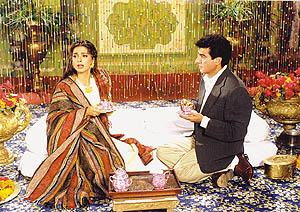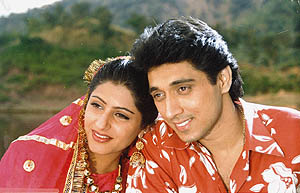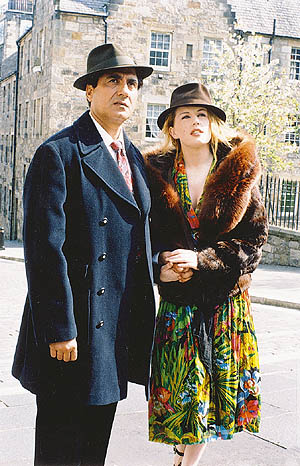| |
A few weeks prior to Mann’s film came
the blockbuster in the shape of Jaspal Bhatti’s
rib-tickling satire on the police force. The
laugh-a-minute comedy Mahaul Theek Hai broke the
33-year-old record of Punjabi films in Chandigarh alone
as it had a successful stint of 13 weeks. Silencing his
detractors, who all along had sniggered that Bhatti
couldn’t possibly sustain humour for three long
hours, he passed the ultimate litmus test as the film
notched points after points on the audience appreciation
scale and celebrated its silver jubilee. Spurred by its
success, the comedy king is all set to release the dubbed
version soon. Three
milestones in a span of two years! Punjabi cinema has
never looked so good. As Vinod Sharma, associated with
public relations of two films Mahaul.... and Shaheed
Uddham...:, gushes: "If ever renaissance in
Punjabi film jagat was possible, this is the
moment". Come to think of it the films came about at
a time when the obituary of Punjabi films had been
written and sealed for posterity to analyse. At a press
conference announcing the launch of Mahaul..., Bhatti
had guffawed: "I am committing a grave
blunder". When he said this, he wasn’t
delivering his patented one-liners. The man was dead
serious. Bhatti confessed: "My friends and
well-wishers thought I had lost my mind. Instead of
congratulating me, they commiserated with me". And
not without reason. Punjabi cinema, despite almost a
seven-decade-old legacy — the first film Heer
Sayal was made in 1932 — has had at best a
chequered career. Hits were more or less like a flash in
the pan. Their brilliance was but ephemeral. Perhaps the
worst blow was dealt when the rule of gun reigned supreme
but even in the post-terrorism days, the industry failed
to see better days. In 1995, the number of films released
was 11, it plummeted to seven in 1996 and touched a low
of five in 1997.
 Like a
breath of fresh air enthusing life into the asphyxiated
industry, these three films have set new standards of
excellence in the Punjabi cine world. Amazingly, the
films belong to different genres and have different
themes. True both Shaheed-e-Mohabbat and Shaheed
Uddham Singh were period pieces. But one was a
heart-rending account of a lovelorn couple torn apart by
the Radcliffe Line, while the other chronicled the saga
of the legendary martyr who, the maker Iqbal Dhillon
insists, had been "forgotten by an ungrateful
nation." Earlier, two award-winning films-- Marhi
da Deeva and Kachheri -- and grossers like Chann
Pardesi were made. But Rupinder Gill, co-producer of
several hit films like Putt Jattan De, agrees that
it has always been a bhed chaal. For instance, out
of the seven films that he produced, nearly all
‘showcased’ the valour of jats. Why the
films even had the word jat in their titles! Like a
breath of fresh air enthusing life into the asphyxiated
industry, these three films have set new standards of
excellence in the Punjabi cine world. Amazingly, the
films belong to different genres and have different
themes. True both Shaheed-e-Mohabbat and Shaheed
Uddham Singh were period pieces. But one was a
heart-rending account of a lovelorn couple torn apart by
the Radcliffe Line, while the other chronicled the saga
of the legendary martyr who, the maker Iqbal Dhillon
insists, had been "forgotten by an ungrateful
nation." Earlier, two award-winning films-- Marhi
da Deeva and Kachheri -- and grossers like Chann
Pardesi were made. But Rupinder Gill, co-producer of
several hit films like Putt Jattan De, agrees that
it has always been a bhed chaal. For instance, out
of the seven films that he produced, nearly all
‘showcased’ the valour of jats. Why the
films even had the word jat in their titles!
Earlier also the mega
success of Nanak Naam Jahaz Hai had spawned a
series of religious films like Nanak Dukhiya Sab
Sansaar, Mitar Pyaare Nu, etc. In the fifties, the
leitmotif running through Punjabi films mirrored the
Punjabi folk dances woven around rural themes. Remarks
Bhatti: "Punjabi audiences have been shortchanged
for far too long and served the same concoction of bhangra
and giddha ad nauseam". Small wonder that
when he made a break from the past, he touched a nerve.
B.N. Sharma, a seasoned actor who has worked in over 30
Punjabi films, agrees: "The maker can no longer
afford to dwell in the past. Besides keeping in sync with
changing times, he must possess a vision. He has to
transcend the present and connect with the future".
 Alas, the tragedy of Punjabi cinema is
that it woefully lacks full-time producers. But for a
rare Dhillon, producers come and go. Some try to
capitalise on the occasional sops offered by the
government, some want to be part of the glamour; but
whatever the motive, the reasons are not strong enough to
cement a permanent bond with the industry. Not that they
can be faulted. Small territory translates into bad
economics. The apathetic attitude of the government,
which has disbanded the subsidy policy but framed no
alternative incentives, only compounds the crisis. But
then a bankrupt government can hardly be expected to pay
heed to "insignificant" matters like culture
and films. Bhatti says: "I feel ashamed to contact
officials in the government. The unanimous refrain of the
officialdom is, "What can we do when he haven’t
ever got our salary?" Dhillon, however, is not that
benevolent. He furiously quotes statistics: "Can you
believe that while other state governments like
Maharashtra offered us tax exemption for one year on any
number of prints, our own Punjab government consented to
grant it only for six weeks and that too only for 10
prints? What more can I say about a government that
hasn’t bothered to institute an award which costs
nothing." Alas, the tragedy of Punjabi cinema is
that it woefully lacks full-time producers. But for a
rare Dhillon, producers come and go. Some try to
capitalise on the occasional sops offered by the
government, some want to be part of the glamour; but
whatever the motive, the reasons are not strong enough to
cement a permanent bond with the industry. Not that they
can be faulted. Small territory translates into bad
economics. The apathetic attitude of the government,
which has disbanded the subsidy policy but framed no
alternative incentives, only compounds the crisis. But
then a bankrupt government can hardly be expected to pay
heed to "insignificant" matters like culture
and films. Bhatti says: "I feel ashamed to contact
officials in the government. The unanimous refrain of the
officialdom is, "What can we do when he haven’t
ever got our salary?" Dhillon, however, is not that
benevolent. He furiously quotes statistics: "Can you
believe that while other state governments like
Maharashtra offered us tax exemption for one year on any
number of prints, our own Punjab government consented to
grant it only for six weeks and that too only for 10
prints? What more can I say about a government that
hasn’t bothered to institute an award which costs
nothing."
In the absence of
government patronage, coupled with the diffident stance
of the media — even vernacular press puts Punjabi
films on the inside pages — the onus is on
individuals. All the three big-budget Punjabi films rode
piggyback on the powerful images of stars, albeit from
different realms. Dhillon unabashedly admits that but for
Raj Babbar, Shaheed Uddham Singh would have never
been made. Apart from contributing in terms of a sterling
performance, he roped in other stars like Juhi Chawla who
agreed to work for free. Insiders, however, argue that
star presence was merely one part of the success story.
Hadn’t Mann acted in films before too? At the end of
the day what brought back the dwindling tribe of Punjabi
cinegoers to theatres was the emphasis on quality. As
Vinod says: "Nearly 7000 feet of Shaheed Uddham
Singh was cut to ensure a slick product." And
the sincere endeavour was bound to pay dividends. Onkar
Singh Bains, a producer who has distributed Shaheed
Udham Singh in Europe and Canada, claims that the
movie is doing brisk business in theatres where even
Hindi blockbusters rarely go beyond four weeks. Maninder
Gill of Raja Entertainers, which possess the audio rights
of the film, says: "Over half-a-million albums have
already been sold thus making it a competitor of Punjabi
pop music. Even CD sales have been unusually high".
 Success
stories breed clones — have these three hits opened
new doors? Do fresh vistas beckon? Yes and no. Sharma,
though happy with the recognition his comic portrayal of
Biloo bakra in Mahaul..., rues that in all
likelihood none of the nine unreleased films he has acted
in will see the light of day. Put simply, even today
there are no takers for Punjabi films, even for
big-budget films like Dard Pardesan De. The only
movie that is likely to hit the big screen in near future
is Sikandra which hopes to recapture the magic of
star jodi Guggu Gill and Yograj Singh. For the
Punjabi film producers, the vicious cycle of low
investment - low returns - low quality remains intact.
The not-so-conducive environment can be gauged from the
fact that producers like Gill haven’t cared to make
a film since 1993. Bhatti, who insists that he
didn’t even make a penny (not even to buy his shoe
laces) out of his film, justifies the mood: "Though
the film industry follows no set rules and tomorrow a
small-budget film might set a new record, the small
producer at this moment is scared and sitting
tight." To say that one good film is better than 10
awful ones is sheer hyperbole. For an industry to
survive, more films have to be made. Success
stories breed clones — have these three hits opened
new doors? Do fresh vistas beckon? Yes and no. Sharma,
though happy with the recognition his comic portrayal of
Biloo bakra in Mahaul..., rues that in all
likelihood none of the nine unreleased films he has acted
in will see the light of day. Put simply, even today
there are no takers for Punjabi films, even for
big-budget films like Dard Pardesan De. The only
movie that is likely to hit the big screen in near future
is Sikandra which hopes to recapture the magic of
star jodi Guggu Gill and Yograj Singh. For the
Punjabi film producers, the vicious cycle of low
investment - low returns - low quality remains intact.
The not-so-conducive environment can be gauged from the
fact that producers like Gill haven’t cared to make
a film since 1993. Bhatti, who insists that he
didn’t even make a penny (not even to buy his shoe
laces) out of his film, justifies the mood: "Though
the film industry follows no set rules and tomorrow a
small-budget film might set a new record, the small
producer at this moment is scared and sitting
tight." To say that one good film is better than 10
awful ones is sheer hyperbole. For an industry to
survive, more films have to be made.
Till the low-budget
film-maker musters enough courage, the industry has come
to depend — heavily at that — on big-time
players. These players not only have the megabucks to
spare but also wield enough clout to pull out all the
stops. More pertinently, they possess an obsessive urge
to pay a cinematic tribute to their mother tongue.
|

